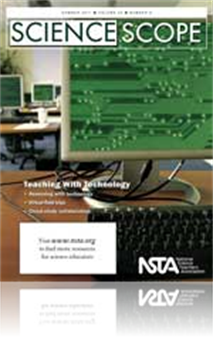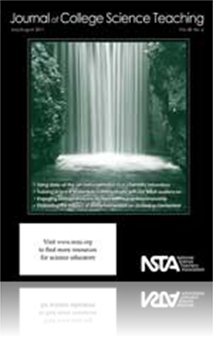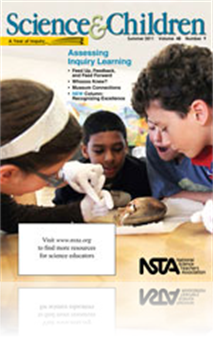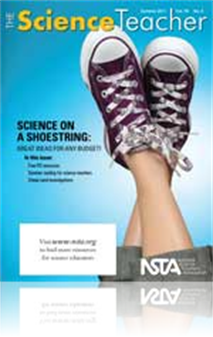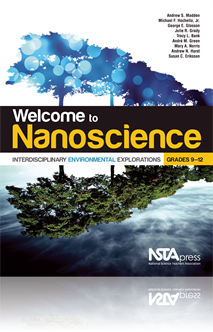All Resources
Journal Article
Exploring Seafloor Volcanoes in Cyberspace: NOAA's <i>Ocean Explorer</i> Inspires Inquiry
Seafloor exploration being done by scientists is an ideal way to introduce students to technology as a tool for inquiry. The same technology that allows scientists to share data in near real time can also provide students the tools to become research...
Journal Article
This article discusses a six-year study that involved an evaluation of whether student-learning gains for an online homework system could be sustained when scaled up to multiple sections and multiple instructors over several years. Results showed tha...
Journal Article
This article discusses instruments given to undergraduate students enrolled in an introductory biology course for nonmajors. These instruments assessed attitudes toward biology and mathematics and various motivational constructs....
Journal Article
The author provides five guidelines for designing inquiry lessons within any grade level....
Journal Article
The New Teacher's Toolbox: Gearing Up for Summer
This column shares tips for teachers just beginning their career. In this month’s issue the author offers tips for how to make the most of the summer months of rejuvenation....
Journal Article
Scope on the Skies: Summer Skies
This column focuses on astronomy throughout the year. In this month’s issue the author discusses objects that appear in the summer sky....
Journal Article
Take advantage of teen internet savvy and redirect students' online travels toward exploration of our environment through streaming real-time data (RTD). Studies have shown that using RTD adds relevancy to students' learning experiences and engages t...
Journal Article
Is There a "Back" of the Room When the Teacher Is in the Middle?
This article describes a study of student seating habits in both a traditional lecture hall with the instructor in the front and in a SCALE-UP (Student-Centered Activities for Large Enrollment Undergraduate Programs) studio-style classroom with the i...
Journal Article
Summer Reading—It's Element-ary
NSTA's reviewers provide suggestions for summer reading for science educators....
Journal Article
Tried and True: No Matter the Weather, We'll Measure Together
This column provides classic demonstrations and experiments with a new twist. In this month’s issue technology-infused weather investigations are explored....
Journal Article
Scope on Safety: Modeling Clay Safety
This column shares safety information for your classroom. In this month’s issue the author discusses the different types of clay and characteristics that determine appropriate use....
Journal Article
The Biology Department at James Madison University assesses scientific and quantitative reasoning skills in STEM majors in a content-independent manner by using a multiple-choice exam called the Natural World-9. The authors discuss methodology they u...
Journal Article
Everyday Engineering: It's (zipped) in the bag
This column provides an inside look at the marvels of engineering in everyday life. In this issue, the origins of the sealable plastic bag are explored....
Journal Article
Chromonoodles: Jump Into the Gene Pool
The authors use pool "noodles" to model chromosomes in the biology classroom. Students gain a greater appreciation of the interdependence of DNA and inherited traits....
Journal Article
Guest Editorial: More Than Just Technology
An opinion piece about integrating technology into teaching....
Journal Article
Safer Science: Know Your Responsibility
This column provides best safety practices for the science classroom and laboratory. This month’s issue discusses safety and liability issues in the science lab....
Journal Article
Students use manipulative models and small-scale simulations that promote learning of complex biological concepts. The authors have developed inexpensive wet-lab simulations and manipulative models for "Diagnosing Diabetes" "A Kidney Problem?" and "A...
Journal Article
Feed Up, Feedback, and Feed Forward
In this article the authors describe how a kindergarten science teacher uses the feed up, feedback, and feed forward inquiry-based approach to assessment during a unit on conservation of resources....
Journal Article
The Early Years: Measuring Learning
This column discusses resources and science topics related to students in grades preK to 2. In this month’s issue the activity assesses what children understand about measurement....
Journal Article
Biology majors team with business administration majors to develop proposals for "green" enterprise for a business plan competition. The experience gives students insight into the dynamics of cross-functional teaming and the challenges of learning di...
Book Chapter
What Are Nanoscience and Nanotechnology? A Nano Primer
In the examples presented in this chapter, the authors have defined the nanoscale and nanoscience. They have seen surprising results for two “ordinary” phenomena that they thought they knew everything about, but which were both shown to have su...
Book Chapter
Historical and Societal Aspects of Nanoscale Science and Technology
The nanorevolution is here to stay. It is this small scale—where we have the ability to put molecules and atoms to new uses—that fuels the hope and hype surrounding nanotechnology. This chapter discuses the origins of nanoscience, nanotechnology ...
Book Chapter
Introduction to Water Pollution
This lesson assesses students’ prior knowledge about groundwater pollution and has students investigate types and sources of water pollution. Note that this introductory activity sets the stage for subsequent learning about sources of water polluti...
Book Chapter
Nanoscale science and technology play central roles in our understanding of how Earth works and in the environmental science field of study. As a freshwater source, groundwater is second in abundance only to water found in glaciers and polar ice. Gro...
Book Chapter
In this lesson, students study the reduction of iron oxide minerals in a simulated anaerobic aquatic environment. Students discuss how the respiration of anaerobic bacteria may be involved with iron reduction. Students also consider problems related ...
Book Chapter
Investigation of Bacterial Transport in Groundwater
Students, in this lesson, explore the transport of bacteria in groundwater by performing a column experiment in a simulated groundwater environment. Students also investigate a groundwater scenario to learn about the influence of groundwater chemistr...
Book Chapter
Nano2Earth Curriculum Overview
The Nano2Earth curriculum is designed to promote student inquiry and learner centered investigations of microbe-mineral interactions at the nanoscale. This chapter shows how the curriculum is organized into lessons and to use the curriculum....
Book Chapter
Nanoforces in Nature: Using Atomic Force Microscopy to Explore Microbe-Mineral Interactions
This lesson uses computer simulations of an atomic force microscope to investigate bacteria-mineral forces of interaction on the order of nanonewtons over nanoscale distances of interaction. In this lesson, students • learn about the atomic force...



